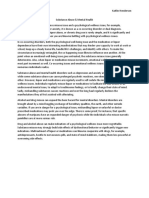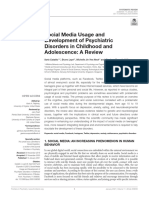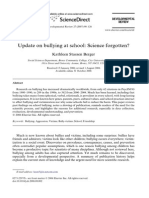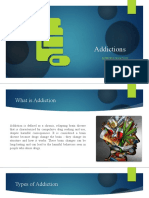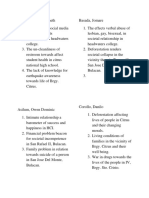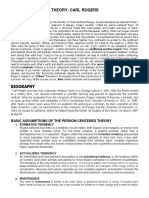Alcohol and Youth
Alcohol and Youth
Uploaded by
Christ AngelinaCopyright:
Available Formats
Alcohol and Youth
Alcohol and Youth
Uploaded by
Christ AngelinaOriginal Title
Copyright
Available Formats
Share this document
Did you find this document useful?
Is this content inappropriate?
Copyright:
Available Formats
Alcohol and Youth
Alcohol and Youth
Uploaded by
Christ AngelinaCopyright:
Available Formats
Alcohol and Youth Alcohol use and abuse is a serious problem among young people.
There are a number of unhealthy risks associated with it, including alcohol dependence, and alcohol related accidents and violence. In fact, the most likely cause of death for a 16 year old is alcohol related. For that a reason, it is important to clearly understand the extent of youth involvement in underage drinking. The statistics on alcohol use should be examined in light of the large number of youth not involved in this unhealthy risk behavior, especially when they are empowered by positive relationships with parents who give them clear direction. More than three-fourths of youth ages 12-17 are not regular drinkers. It is very encouraging that despite some sensational headlines and tragic incidents related to alcohol use and abuse, data from the past two decades show a continuing trend of decreasing youth alcohol use. One major area of concern remains; however, the increasing percentage of teens who binge drink. Although the overall, long-term trend in youth alcohol use is decreasing, specific categories of drinking behavior may rise or fall during a certain year. Statistics from different sources may vary due to a multitude of factors, including differing methods of data collection; choices of age ranges and time periods; measurements of perception versus actual use; reporting by rates or actual numbers; and definitions of use. Through this overview of statistics, IYD hopes to provide the reader with a comprehensive picture of youth risk behaviors, recognizing that some specific statistics may seem to indicate inconsistent trends or levels of use. Lifetime In the past year In the past month2 Source: 1997 1998 PRIDE Survey Prevalence of youth alcohol use Current use (at least one drink in the past
month) among youth ages 12-17 has been declining since 1979 (49.8 percent), with 1996 levels of current use being reported at18.8 percent. For high-achieving students, the number was even lower, with only nine percent reporting they drank alcoholic beverages on a monthly basis. Similar findings from the National Longitudinal Study of Adolescent Health (known as Add Health), a federally sponsored study of more than 90,000 teens, found 17.9 percent of teens drink alcohol more than once a month, and 10 percent reported drinking, weekly. In examining pastyear drinking of beer, the PRIDE Questionnaire Report revealed increasing alcohol use with age:17.7 percent of sixth graders, 40.4 percent of eighth graders, 56.9 percent of tenth graders and 64.5 percent of twelfth graders. Understandably, the number of students who have ever tried alcohol is significantly higher than those who regularly drink alcohol. Eighty percent of students have tried alcoholby the twelfth grade. Fifty-six percent of eighth graders report ever having used alcohol Binge drinking, which is having five or more drinks in a row, can have serious health risks. Although binge drinking levels are lower than they were in the 1980s, there is still a significant minority of youth who aree engaging in this risky behavior. Binge drinking levels increase throughout adolescence and peak at ages 18-22. According to one annual survey of youth, 16 percent of eighth graders, 25 percent of tenth graders and 30 percent of twelfth graders reported binge drinking in the past two weeks. Recent 1997 data on binge drinking among college students found that 52 percent of college alcohol drinkers binge drink an increase from 39 percent in 1993.
Characteristics of adolescent alcohol users Not surprisingly, significantly fewer junior high school students drink alcohol compared to high school students; and slightly more males than females drink more than once a month or binge drink. Black adolescents have the lowest risk of alcohol use compared to white and Hispanic youth. Suburban youth reported the highest level of drinking with nearly one in five drinking twice a month or more. Also, private high school students report less drinking among their peers than public high school students. Within the past year how often have you drink alcohol?(Grades 6 12)3Youth in families with both biological parents report less alcohol use or dependence than those in families without both biological parents present (i.e. stepparent families, one parent families and other family types).
First use trends The age at which young people initiate this risk behavior is another critical factor for consideration. While overall youth alcohol use rates give a perspective on current participation, age of first use is vital to an understanding of present and future trends. Experts agree that age of initiation is a powerful predictor of consequences and dependence. Studies suggest that adolescents who begin alcohol use at early ages not only use it more frequently, but also escalate to more frequent use more quickly and are less likely to stop using. Although overall youth drinking levels are decreasing, adolescents who do drink are beginning earlier. The current average age of drinking initiation is 15.9 years, compared to17.4 years in 1987. (footnote currently 13) From 1989 to 1995, the rate of initiation of alcohol use among 12 to 17 year olds increased from 113 to 165 per 1,000 person years. This is an alarming trend in light of findings by the National Institute on Alcohol Abuse and Alcoholism. Researchers found the younger the age of drinking onset, the greater the change of the individual developing an alcohol disorder. Young people who begin drinking before the age of 15 are more than twice as likely to develop alcohol abuse and are four times more likely to develop alcohol dependence than thosewho began drinking at or after age 21.Youth perceptions about alcohol use Youth perception about the extent and harmfulness of alcohol use can certainly affect.
Source: The Monitoring the Future Study, 1975-1994 Twelfth graders who disapprove or strongly disapprove of: Trying 1 or 2 drinks Taking 1 or 2 drinks nearly every day Having 5 or more drinks each weekend. Assault with weapon Hit to hurt Gang fight Had sex Youth Violence, Sex & Substance Use Source: Juvenile Offenders and Victims: A National Report. No Use Beer, wine, or tobacco U.S. Department of Justice Liquor Marijuana whether or not adolescents are involved in this activity. If adolescents believe most of their friends drink, their behavior may be affected by a desire to feel normal.Despite the minority of students who report drinking on a regular basis, many students perceive that alcohol use is prevalent among high school students. Eighty-one percent of students surveyed by Whos Who Among American High School Students report a lot of alcohol use at their school. Youths perceptions of harmfulness of alcohol and their disapproval of alcohol use, also affects underage drinking levels. Less than half of youth (45 percent) ages 12-17 believe there is great risk in having five or more drinks once or twice a week a decrease from 58 percent in 1992 who considered that to be a risky behavior. It should be noted in the same time period when perceived harmfulness and disapproval levels decreased, binge drinking levels slightly increased.
Alcohols interconnections with other risk behaviors While involvement in one risk behavior does not guarantee involvement in another, it does increase the likelihood that a young person will participate in other risk behaviors. The use of a substance like alcohol places an adolescent at greater risk for engaging in sexual activity or violence, or for abusing other substances. The Alan Guttmacher Institute, in its report, Sex and Americas Teenagers, stated that young Teenagers who use alcohol and other substances on a regular basis are more likely to be having sex. Also, substance abuse may impair a young persons ability to make sound decisions, especially in regards to sexual activity. Nationwide, among students who are currently sexually active, one-fourth reported they had used Other research shows the misuse of alcohol often results in an earlier onset of sexual activity. According to the Centers for Disease Control and Prevention (CDC), there are strong relationships between the use of alcohol and other substances. Three quarters of smokers ages 12-21 (compared to less than one-fourth of those who have never smoked) had consumed alcohol in the last thirty days. In addition, other studies Source: Juvenile Offenders and Victims: A National Report, U.S. Department of Justice5
have found past month alcohol users ages 12-17 were almost eight times more likely to report illicit drug use. In addition, linkages between alcohol and juvenile delinquency and violence seem to exist. Both junior- and senior-high students who reported using substances (including liquor, marijuana, cocaine and inhalants) were significantly more likely to carry a gun to school, participate in gang activities, consider suicide often, threaten someone, or get into trouble with police. Students who report easy access to controlled substances like alcohol and illicit drugs were more likely to report violent acts at school such as physical attack, robbery, and bullying, than those students who reported little access to controlled substances, according to the U.S. Department of Justice. Of students who knew of peers attending school drunk, 56 percent reported violent acts at their school. Only 36 percent of students who did not know of fellow students who came to school drunk reported violence. The impact of parents and family on underage drinking Parent relationships and family life strongly impact whether or not a youth will be involved in risk behaviors, including alcohol use. Children whose parents tell them to avoid alcohol are less likely to drink alcohol. For instance, in a poll of high-achieving high school students, of those students who reported their parents forbid them to drink (88 percent), 69 percent had never tried alcoholic beverages. In contrast, children of parents who have favorable attitudes about drinking are more likely to initiate and continue to drink. The Add Health study also found parents play a significant role in protecting children from alcohol use. Students were protected against alcohol use if they felt parental connectedness, which was defined by researchers as a sense of closeness to parents
and feeling loved and cared for by parents. Parental presence was found to be another protective factor against alcohol use, although to a lesser degree. However, students who reported easy access to alcohol in the home were more likely to drink alcohol. The IYD approach Recognizing the links between the major youth risk behaviors, the Institute for Youth Development (IYD) promotes a comprehensive risk avoidance message for multiple unhealthy behaviors, including underage drinking. IYD believes that youth are capable of making the healthy decision to avoid alcohol completely, especially if they are empowered by positive relationships with their parents and family. Written by Kimberly Erickson Research assistance provided by Vi Nguyen6 Last updated October 1998 To receive additional copies of this publication or a list of other IYD publications that are available, please contact the Institute for Youth Development at 703-471-8750. The National Council on Alcoholism and Drug Dependence, Inc. Facts about Americas numberone drugg problem. [news release] 1998 April. Issued by funding/ sponsoring agency: Johnston LD, OMalley PM, Bachman JG. National survey results on drug use from The Monitoring the Future Study, 1975-1995, Volume 1, Secondary school students.
Rockville (MD): U.S. Department of Health and Human Services, The National Institute on Drug Abuse;1996. PRIDE. PRIDE questionnaire report: 1997-1998 national summary grades 6 through 12. Atlanta: PRIDE;1998. Issued by funding/ sponsoring agency: Johnston LD, OMalley PM, Bachman JG. National survey results on drug use from The Monitoring the Future Study, 1975-1995, Volume 1, Secondary school students. Issued by funding/ sponsoring agency: Johnson RA, Hoffmann JP, Gerstein, DR. The relationship between family structure and adolescent substance use. Rockville (MD): U.S. Department of Health and Human Services, The Substance Abuse and Mental Health Services Administration, Office of Applied Studies; 1996. Johnson, RA, Gerstein, DR. Initiation of use of alcohol, cigarettes, marijuana, cocaine, and other substances in US birth cohorts since 1919. Am J Public Health. 1998; 88:27-33.
You might also like
- Marcel Case StudyDocument5 pagesMarcel Case StudyPrismatic Ray100% (1)
- Social Work Capstone PaperDocument8 pagesSocial Work Capstone PaperHaley WhitmanNo ratings yet
- SelfRegulation Questionnaire (SRQ)Document9 pagesSelfRegulation Questionnaire (SRQ)Nani Warnasari50% (2)
- PUB 540 Topic 4 Calculating Ratio OddsDocument6 pagesPUB 540 Topic 4 Calculating Ratio OddsKevin Nyasogo100% (1)
- MEMO Grade 10 LO Exam Term 4 - 2020 NovemberDocument7 pagesMEMO Grade 10 LO Exam Term 4 - 2020 NovemberPromise MolapoNo ratings yet
- The Prevalence of Substance Use and Other Mental Health Concerns Among American AttorneysDocument7 pagesThe Prevalence of Substance Use and Other Mental Health Concerns Among American AttorneysDavid AndreattaNo ratings yet
- Sample Substance Use Conceptualization and Treatment PlanDocument9 pagesSample Substance Use Conceptualization and Treatment PlanNORAZLINA BINTI MOHMAD DALI / UPM100% (2)
- Victims of CrimeDocument11 pagesVictims of Crimesuela35100% (1)
- Mixed Method Reasearch On Social Media in The Influence of DepressionDocument57 pagesMixed Method Reasearch On Social Media in The Influence of DepressionLlordie MontecarloNo ratings yet
- CASE VIGNETTE Conduct DisorderDocument1 pageCASE VIGNETTE Conduct DisorderAnonymous S0MyRH100% (1)
- Capstone PaperDocument11 pagesCapstone Paperapi-300946501No ratings yet
- Hair Chapter 10 Binge Drinking QuestionnaireDocument4 pagesHair Chapter 10 Binge Drinking QuestionnaireCatrinel GanciuNo ratings yet
- Ethical, Legal, and Professional Issues: Sattler Chapter 3Document18 pagesEthical, Legal, and Professional Issues: Sattler Chapter 3alex cabralNo ratings yet
- Knowledge and Attitude of The Adolescent Students Regarding Psychoactive Substance Abuse-Exploratory StudyDocument13 pagesKnowledge and Attitude of The Adolescent Students Regarding Psychoactive Substance Abuse-Exploratory StudyAmit TamboliNo ratings yet
- Alyssa PR AileenDocument3 pagesAlyssa PR AileenJonnalyn TorresNo ratings yet
- Social Norms Marketing Social Networks and Alcohol ConsumptionDocument495 pagesSocial Norms Marketing Social Networks and Alcohol ConsumptionHappy IbiNo ratings yet
- What Is AddictionDocument12 pagesWhat Is Addictionelalusin@yahoo.com100% (1)
- Case PresentationDocument16 pagesCase Presentationapi-430313565No ratings yet
- Substance Abuse & Mental HealthDocument1 pageSubstance Abuse & Mental Healthkaitlin100% (1)
- Social Media Usage and Development of Psychiatric Disorders in Childhood and AdolescenceDocument15 pagesSocial Media Usage and Development of Psychiatric Disorders in Childhood and AdolescencerexforthNo ratings yet
- Berger 2007Document37 pagesBerger 2007efunctionNo ratings yet
- Delmundo 2019 - FinalDocument9 pagesDelmundo 2019 - FinalCall me PinguNo ratings yet
- Literature ReviewDocument13 pagesLiterature ReviewShelia Brim ChaseNo ratings yet
- Field Study 1: University of Caloocan CityDocument7 pagesField Study 1: University of Caloocan CityLovelyn MaristelaNo ratings yet
- RRLDocument15 pagesRRLLorelyn TriciaNo ratings yet
- Case PresentationDocument22 pagesCase Presentationapi-295014480No ratings yet
- Schizophrenia Research PaperDocument9 pagesSchizophrenia Research Paperapi-256472698No ratings yet
- Factitious DisorderDocument15 pagesFactitious DisorderMenda SaiVandana100% (1)
- Counseling in SchoolsDocument8 pagesCounseling in Schoolsapi-549222628No ratings yet
- Intake AssessmentDocument2 pagesIntake Assessmentyourzxtruly0% (1)
- Hallucinogen Related DisordersDocument13 pagesHallucinogen Related DisordersHillary BalderasNo ratings yet
- Effect of BullyingDocument11 pagesEffect of BullyingAnonymous 2ch6hSNo ratings yet
- What Is Psychological First Aid?Document4 pagesWhat Is Psychological First Aid?Jianica SalesNo ratings yet
- Research Final g11Document45 pagesResearch Final g11Adrian CasajeNo ratings yet
- Addictions: Eshgin JavadovDocument15 pagesAddictions: Eshgin JavadovEshginNo ratings yet
- ACU Eating Disorders 2014 - SlidesDocument6 pagesACU Eating Disorders 2014 - SlidesChris ParkerNo ratings yet
- Outcomes Map Mental HealthDocument16 pagesOutcomes Map Mental HealthMayniarAyuRahmadianti100% (1)
- Elimination DisordersDocument7 pagesElimination DisordersGladysh Jera QuinagonNo ratings yet
- Relationship Between Parenting Styles and Depression in AdolescentsDocument12 pagesRelationship Between Parenting Styles and Depression in AdolescentsSantosoNo ratings yet
- NEW RESEARCH AntipshychoticDocument319 pagesNEW RESEARCH AntipshychoticLaura BechtolsheimerNo ratings yet
- Cns 6161 Treatment Plan - WalterDocument7 pagesCns 6161 Treatment Plan - Walterapi-263972200No ratings yet
- Schizophrenia Final PaperDocument6 pagesSchizophrenia Final Paperchad5844No ratings yet
- Semi Structured QuestionnaireDocument2 pagesSemi Structured QuestionnaireGlenn BalindotNo ratings yet
- SMUS ManuscriptDocument57 pagesSMUS Manuscriptsanikasvedak15022003No ratings yet
- Survey-Questionnaire-1 RESEARCHDocument2 pagesSurvey-Questionnaire-1 RESEARCHRowena GregorioNo ratings yet
- Covid's Impact On Mental HealthDocument2 pagesCovid's Impact On Mental HealthReinaldoGruberNo ratings yet
- T Groups and Sensitivity TrainingDocument2 pagesT Groups and Sensitivity Training20-22 MUSKAAN AGGARWALNo ratings yet
- Mental Status ExaminationDocument2 pagesMental Status ExaminationEna RodasNo ratings yet
- Conduct Disorder Fact Sheet - K. Elise Parker PDFDocument2 pagesConduct Disorder Fact Sheet - K. Elise Parker PDFepaka02No ratings yet
- Oppositional Defiant Disorders Case Study FinalDocument7 pagesOppositional Defiant Disorders Case Study Finalmotivated165No ratings yet
- Chapter 2 1Document5 pagesChapter 2 1Ayisha AskaNo ratings yet
- Research Philosophy and Paradigms NotesDocument11 pagesResearch Philosophy and Paradigms NotesBenson Baraza100% (1)
- Pdhpe Assessment Task Term 1 Drug Use in AdolescentsDocument10 pagesPdhpe Assessment Task Term 1 Drug Use in Adolescentsapi-463236687100% (2)
- Research TitleDocument4 pagesResearch Titlejake doinogNo ratings yet
- Self-Esteem, Adjustment, Psychological Well-Being and AcademicDocument20 pagesSelf-Esteem, Adjustment, Psychological Well-Being and AcademicSt EfaniNo ratings yet
- Conduct DisorderDocument4 pagesConduct DisorderPrakriti KohliNo ratings yet
- HSC 421 Research PaperDocument13 pagesHSC 421 Research Paperapi-502687231No ratings yet
- Group 3 (Remedies of Structural Violence)Document16 pagesGroup 3 (Remedies of Structural Violence)Urooj ZafarNo ratings yet
- Abdullah Afnan KanzaDocument3 pagesAbdullah Afnan KanzaKanza Waheed100% (1)
- The Level of Stress Among College Students A CaseDocument18 pagesThe Level of Stress Among College Students A CaseStephany Faye Batas Aguilar100% (1)
- Causes and Effects of Alcoholism Among YouthDocument99 pagesCauses and Effects of Alcoholism Among Youthjamessabraham2No ratings yet
- I. Person-Centered Theraphy Carl RogersDocument4 pagesI. Person-Centered Theraphy Carl RogersMaja Aira Bumatay100% (1)
- KYoung Internetaddiction5 PDFDocument21 pagesKYoung Internetaddiction5 PDFSel EscutinNo ratings yet
- Barbados Secondary School Survey 2013Document129 pagesBarbados Secondary School Survey 2013DIEGO ALBERTO ESCOBAR RIFFONo ratings yet
- Parental Influence and Peer Pressure College Students' Susceptibility To Alcohol UseDocument9 pagesParental Influence and Peer Pressure College Students' Susceptibility To Alcohol UseInternational Journal of Innovative Science and Research TechnologyNo ratings yet
- Thesis Statement On Drinking Alcohol EssaysDocument4 pagesThesis Statement On Drinking Alcohol Essayserinmooreeverett100% (2)
- AlcoholismDocument30 pagesAlcoholismEswar StarkNo ratings yet
- Project 6240Document31 pagesProject 6240api-640983441No ratings yet
- Effects of Drinking LiquorDocument15 pagesEffects of Drinking LiquorTrond IturriosNo ratings yet
- Thesis Statement For Lowering The Drinking Age To 18Document4 pagesThesis Statement For Lowering The Drinking Age To 18jilllyonstulsa100% (2)
- Alcohol Drug AwarenessDocument147 pagesAlcohol Drug AwarenessMarkNo ratings yet
- 0 ELNAR Managbanag ALCOHOLISM - Edited Version 3Document19 pages0 ELNAR Managbanag ALCOHOLISM - Edited Version 3Ningning RomarateNo ratings yet
- Drink Water or DieDocument10 pagesDrink Water or DieBraden MaloyNo ratings yet
- Chapter 13Document28 pagesChapter 13Kayelita Wu100% (2)
- Family Research Synthesis PaperDocument12 pagesFamily Research Synthesis Paperapi-542033819No ratings yet
- CHAPTER 1 FinalDocument5 pagesCHAPTER 1 FinalMEKA ELA MALINAO100% (1)
- Teenage Drink and Drug Abuse RifeDocument5 pagesTeenage Drink and Drug Abuse RifeMatt WeirNo ratings yet
- Alcohol One Deadly NightDocument3 pagesAlcohol One Deadly NightGabriel ParksNo ratings yet
- Drinking Age DebateDocument9 pagesDrinking Age Debateapi-349784477No ratings yet
- Thesis Statement On Minimum Drinking AgeDocument8 pagesThesis Statement On Minimum Drinking Agevxjtklxff100% (2)
- QNADA NewsletterDocument12 pagesQNADA NewsletterYoungPeopleAheadNo ratings yet
- E2 Legal Drinking AgeDocument4 pagesE2 Legal Drinking Ageapi-242129114No ratings yet
- Ellyson CV Aug2023Document8 pagesEllyson CV Aug2023api-260414648No ratings yet
- Tata Institute of Social Sciences, GuwahatiDocument11 pagesTata Institute of Social Sciences, Guwahativihaan chaudharyNo ratings yet
- Drug Prevalence Secondary FINAL (2013) - BelizeDocument57 pagesDrug Prevalence Secondary FINAL (2013) - BelizeIon Cacho100% (2)
- Abnormal Psychology Case StudyDocument6 pagesAbnormal Psychology Case StudyGreysi Alvarez67% (3)
- CAGE Test Alcool, CAGE Test Droguri, Test AUDIT Pentru Alcoolism. Ce Este Adictia. Coping Si TratamentDocument35 pagesCAGE Test Alcool, CAGE Test Droguri, Test AUDIT Pentru Alcoolism. Ce Este Adictia. Coping Si TratamentAnonymous KgUtPlkjNo ratings yet
- 21: Science's Limit When It Comes To The Drinking Age: by Jen Christensen, CNNDocument3 pages21: Science's Limit When It Comes To The Drinking Age: by Jen Christensen, CNNapi-260189186No ratings yet




















